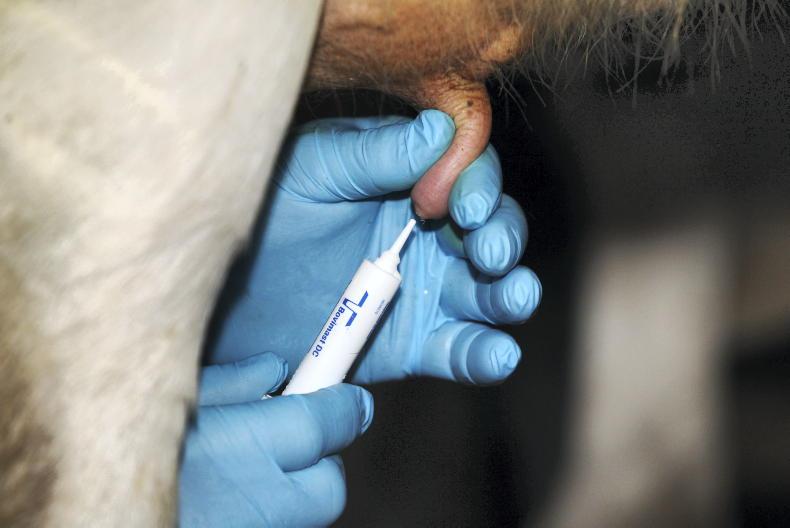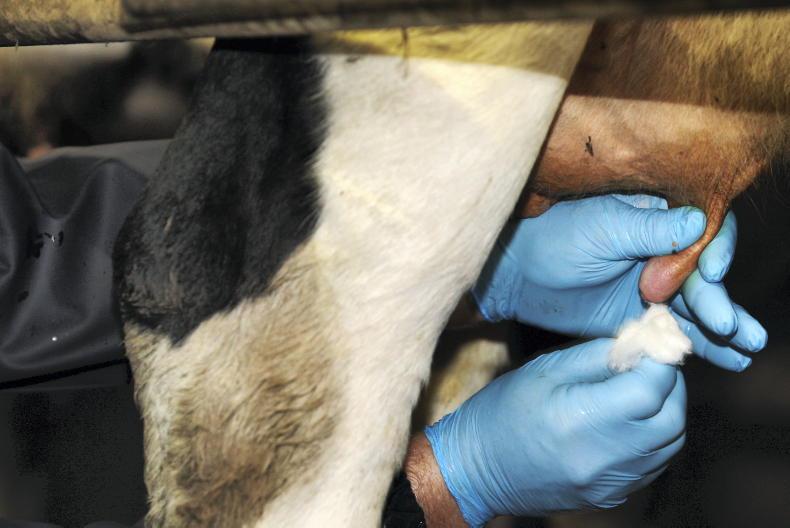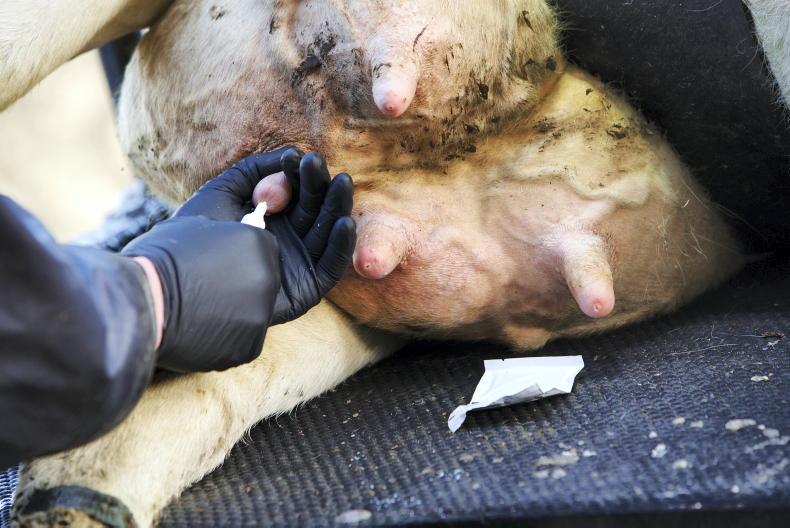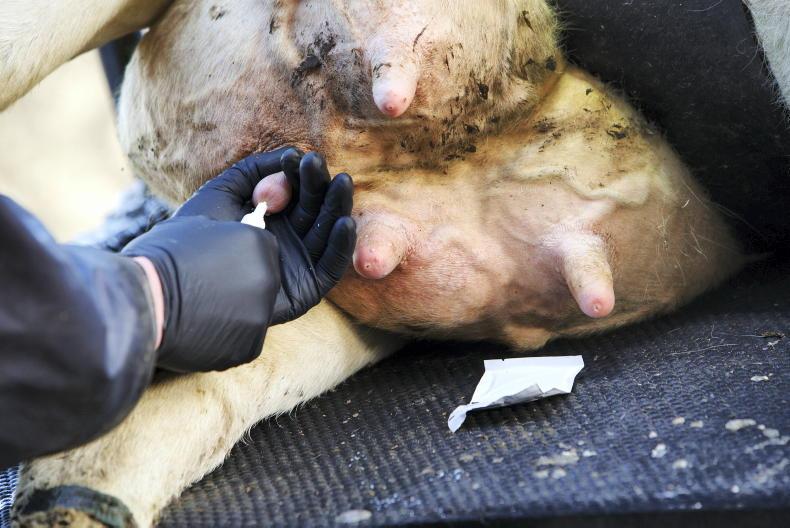The dry period is a crucial time, when new udder infections can be picked up leading to mastitis, even though the symptoms of mastitis may not be seen until the next lactation.
While you may not be planning to dry off the herd just yet, there are things that you can do now to make sure that you are prepared.
Advance preparation
Review expected calving dates to ensure a sufficient dry period (six to 12 weeks depending on lactation and body condition score) is achieved.
Carry out milk recording within a month of drying off, followed by another in early 2022 to allow you evaluate the success of your dry period, including cure rates and any new infections that were picked up during the dry period.
If necessary, manage production levels in advance of drying off. Where cows are yielding greater than 12l/day in the week before you plan to dry them off, reduce pasture and concentrate availability, but not water access.
Have the cows’ tails clipped to ensure better hygiene. Dry off abruptly and avoid skipping milkings in the days leading up to drying off.
On the day
Drying off is an important job, requiring your complete attention. Drying off should be a separate job and not done during milking.
If your goal is to dry off the last cow as well as you did the first cow, then no more than 20 cows should be done at a time.
Avoid drying off cows when you are tired, hungry, or stressed and organise help, as drying off cows properly is a slow and tedious job.
Have the necessary equipment ready including a clean apron, disposable gloves, teat wipes or cotton balls and surgical spirits, marker and intramammary tubes.
If necessary, teat sealer tubes can be warmed by placing in a warm room overnight or putting in a dry bucket and placing this bucket in a bucket of warm water.
Do not place the tubes directly in warm water, as it increases the risk of contamination.

It helps to have these items laid out on a table before you begin or on the opposite side of the parlour from where you are working.
Invest in a head torch so you can see what you are doing. Have a system in place for cleaning, sterilising and tubing teats and repeat for each cow. Clean the parlour between batches to reduce risk of contamination.
Ensure teats are disinfected well after drying off.

To avoid any errors, good identification of cows and accurate record keeping are critically important.
Avoid drying off cows in wet weather as wet tails and udders make it hard to keep things clean.
What to do after drying off
Stand the cows in a clean yard for thirty minutes after drying off. Clean and lime cubicles twice daily for the entire duration of the dry cow period.
Correct dry cow nutrition and sufficient cubicle numbers (ideally 110 for every 100 cows) allow for normal cow behaviour and are essential during the dry period.
To help farmers evaluate their housing and management practices during the dry period, CellCheck is developing a self-assessment checklist for winter housing.
This will help you examine your own winter housing and management practices with a view to preventing mastitis, while outlining small changes that you can make to reduce mastitis during the dry period.
This self-assessment tool will be launched online during the CellCheck Virtual Week which is taking place from 18 to 22 October.
Protecting precious antibiotics
From January 2022, changes will have to be made to how antibiotics are used to ensure they remain effective for both human and animal health in the future, and one of these changes will involve a move away from “blanket dry cow” therapy and adopt “selective drying off strategies”. This is when only selected cows, ie those with infected quarters, are treated with antibiotics at drying off.
Internal teat sealer is often then used in the remainder of the herd as one of the measures to prevent new infections during the dry period.
In addition, some of the dry cow tubes contain antibiotics that are a last resort for treating human infections and should not be used as a first line treatment.
Procedure
While a selective drying off strategy is considered a more prudent use of antibiotics, this practice is not without risk.
Put time aside to discuss the drying off procedure and appropriate dry cow antibiotic selection with your veterinary practitioner.
Consider applying for a funded CellCheck “Dry Cow Consult”, delivered by your trained veterinary practitioner. See Animal Health Ireland/CellCheck for more information.
As part of the consultation, milk recording results and farm records will be reviewed, as well as current practices when drying off cows, to help develop and plan drying off strategies for your farm.
Another resource available to you, to help you prepare for this dry season is the new CellCheck leaflet demonstrating what is involved in hygienic and effective tubing at drying-off. Each dairy farmer will receive a copy of this leaflet with their ICBF reports this month.
Monday 18 October: Prof Martin Cormican – why changes are necessary to antibiotic use in human and animal health.Tuesday 19 October: winter housing – preventing and managing mastitis for a successful dry period.Wednesday 20 October: tubing – effective tubing of cows in the parlour and perfecting your technique.Thursday 21 October: milk recording – the benefits and farmers discuss their experiences.Friday 22 October: supports – the CellCheck programme including the TASAH-funded Dry Cow Consults.
Links to each day’s key messages will be sent out by your co-op by text.
The dry period is a crucial time, when new udder infections can be picked up leading to mastitis, even though the symptoms of mastitis may not be seen until the next lactation.
While you may not be planning to dry off the herd just yet, there are things that you can do now to make sure that you are prepared.
Advance preparation
Review expected calving dates to ensure a sufficient dry period (six to 12 weeks depending on lactation and body condition score) is achieved.
Carry out milk recording within a month of drying off, followed by another in early 2022 to allow you evaluate the success of your dry period, including cure rates and any new infections that were picked up during the dry period.
If necessary, manage production levels in advance of drying off. Where cows are yielding greater than 12l/day in the week before you plan to dry them off, reduce pasture and concentrate availability, but not water access.
Have the cows’ tails clipped to ensure better hygiene. Dry off abruptly and avoid skipping milkings in the days leading up to drying off.
On the day
Drying off is an important job, requiring your complete attention. Drying off should be a separate job and not done during milking.
If your goal is to dry off the last cow as well as you did the first cow, then no more than 20 cows should be done at a time.
Avoid drying off cows when you are tired, hungry, or stressed and organise help, as drying off cows properly is a slow and tedious job.
Have the necessary equipment ready including a clean apron, disposable gloves, teat wipes or cotton balls and surgical spirits, marker and intramammary tubes.
If necessary, teat sealer tubes can be warmed by placing in a warm room overnight or putting in a dry bucket and placing this bucket in a bucket of warm water.
Do not place the tubes directly in warm water, as it increases the risk of contamination.

It helps to have these items laid out on a table before you begin or on the opposite side of the parlour from where you are working.
Invest in a head torch so you can see what you are doing. Have a system in place for cleaning, sterilising and tubing teats and repeat for each cow. Clean the parlour between batches to reduce risk of contamination.
Ensure teats are disinfected well after drying off.

To avoid any errors, good identification of cows and accurate record keeping are critically important.
Avoid drying off cows in wet weather as wet tails and udders make it hard to keep things clean.
What to do after drying off
Stand the cows in a clean yard for thirty minutes after drying off. Clean and lime cubicles twice daily for the entire duration of the dry cow period.
Correct dry cow nutrition and sufficient cubicle numbers (ideally 110 for every 100 cows) allow for normal cow behaviour and are essential during the dry period.
To help farmers evaluate their housing and management practices during the dry period, CellCheck is developing a self-assessment checklist for winter housing.
This will help you examine your own winter housing and management practices with a view to preventing mastitis, while outlining small changes that you can make to reduce mastitis during the dry period.
This self-assessment tool will be launched online during the CellCheck Virtual Week which is taking place from 18 to 22 October.
Protecting precious antibiotics
From January 2022, changes will have to be made to how antibiotics are used to ensure they remain effective for both human and animal health in the future, and one of these changes will involve a move away from “blanket dry cow” therapy and adopt “selective drying off strategies”. This is when only selected cows, ie those with infected quarters, are treated with antibiotics at drying off.
Internal teat sealer is often then used in the remainder of the herd as one of the measures to prevent new infections during the dry period.
In addition, some of the dry cow tubes contain antibiotics that are a last resort for treating human infections and should not be used as a first line treatment.
Procedure
While a selective drying off strategy is considered a more prudent use of antibiotics, this practice is not without risk.
Put time aside to discuss the drying off procedure and appropriate dry cow antibiotic selection with your veterinary practitioner.
Consider applying for a funded CellCheck “Dry Cow Consult”, delivered by your trained veterinary practitioner. See Animal Health Ireland/CellCheck for more information.
As part of the consultation, milk recording results and farm records will be reviewed, as well as current practices when drying off cows, to help develop and plan drying off strategies for your farm.
Another resource available to you, to help you prepare for this dry season is the new CellCheck leaflet demonstrating what is involved in hygienic and effective tubing at drying-off. Each dairy farmer will receive a copy of this leaflet with their ICBF reports this month.
Monday 18 October: Prof Martin Cormican – why changes are necessary to antibiotic use in human and animal health.Tuesday 19 October: winter housing – preventing and managing mastitis for a successful dry period.Wednesday 20 October: tubing – effective tubing of cows in the parlour and perfecting your technique.Thursday 21 October: milk recording – the benefits and farmers discuss their experiences.Friday 22 October: supports – the CellCheck programme including the TASAH-funded Dry Cow Consults.
Links to each day’s key messages will be sent out by your co-op by text.












SHARING OPTIONS